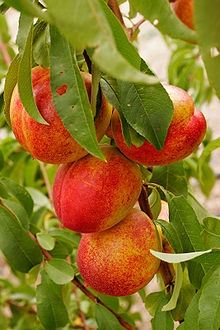Nectarine: Difference between revisions
No edit summary |
|||
| Line 1: | Line 1: | ||
| ⚫ | '''Nectarine''' is a [[cultivar group]] of [[peach]] that has a smooth, fuzzless skin. Though fuzzy peaches and nectarines are commercially regarded as different fruits, with nectarines often erroneously believed to be a crossbreed between peaches and [[plum]]s, or a "peach with a plum skin", they belong to the same species as peaches. Several genetic studies [http://food.oregonstate.edu/faq/uffva/nectarine2.html] have concluded in fact that nectarines are created due to a [[recessive gene]], whereas a fuzzy peach skin is [[dominant gene|dominant]]. Nectarines have arisen many times from peach trees, often as [[bud sport]]s. |
||
'''Nectarine''' is a [[cultivar group]] of [[peach]] that has a smooth, fuzzless skin. A peach without furry skin. |
|||
| ⚫ | Though fuzzy peaches and nectarines are commercially regarded as different fruits, with nectarines often erroneously believed to be a crossbreed between peaches and [[plum]]s, or a "peach with a plum skin", they belong to the same species as peaches. Several genetic studies [http://food.oregonstate.edu/faq/uffva/nectarine2.html] have concluded in fact that nectarines are created due to a [[recessive gene]], whereas a fuzzy peach skin is [[dominant gene|dominant]]. Nectarines have arisen many times from peach trees, often as [[bud sport]]s. |
||
Nectarines can be white or yellow, and clingstone or freestone, although nectarine skins are generally more reddish than those of peaches, contributing to the fruit's plum-like appearance. Regular peach trees occasionally produce a few nectarines, and vice versa. The former is more common, but nectarine trees can grow peaches if the nectarine tree receives [[pollen]] from a peach tree or contains a peach tree [[graft]]. Their flesh is generally moister, sweeter, and more easily bruised than peaches, although many peaches are identical in all aspects to nectarines except for the skin. The history of the nectarine is unclear; the first recorded mention is from [[1616]] in [[England]], but they had probably been grown much earlier in central Asia. |
Nectarines can be white or yellow, and clingstone or freestone, although nectarine skins are generally more reddish than those of peaches, contributing to the fruit's plum-like appearance. Regular peach trees occasionally produce a few nectarines, and vice versa. The former is more common, but nectarine trees can grow peaches if the nectarine tree receives [[pollen]] from a peach tree or contains a peach tree [[graft]]. Their flesh is generally moister, sweeter, and more easily bruised than peaches, although many peaches are identical in all aspects to nectarines except for the skin. The history of the nectarine is unclear; the first recorded mention is from [[1616]] in [[England]], but they had probably been grown much earlier in central Asia. |
||
Revision as of 17:03, 4 September 2007
Nectarine is a cultivar group of peach that has a smooth, fuzzless skin. Though fuzzy peaches and nectarines are commercially regarded as different fruits, with nectarines often erroneously believed to be a crossbreed between peaches and plums, or a "peach with a plum skin", they belong to the same species as peaches. Several genetic studies [1] have concluded in fact that nectarines are created due to a recessive gene, whereas a fuzzy peach skin is dominant. Nectarines have arisen many times from peach trees, often as bud sports.
Nectarines can be white or yellow, and clingstone or freestone, although nectarine skins are generally more reddish than those of peaches, contributing to the fruit's plum-like appearance. Regular peach trees occasionally produce a few nectarines, and vice versa. The former is more common, but nectarine trees can grow peaches if the nectarine tree receives pollen from a peach tree or contains a peach tree graft. Their flesh is generally moister, sweeter, and more easily bruised than peaches, although many peaches are identical in all aspects to nectarines except for the skin. The history of the nectarine is unclear; the first recorded mention is from 1616 in England, but they had probably been grown much earlier in central Asia.

Production trends

FAO reports that China and Italy were the top producers of peaches and nectarines in 2005.
